Like NE Cully Boulevard before it, SW Multnomah Boulevard has become a relatively far-flung street with a few blocks of one of the city’s best bike lanes.
With work nearly finished on the city’s eighth protected bike lane — three years in the making, it’s one of the last few bike projects begun under the Sam Adams mayoral administration — I stopped by Multnomah Tuesday to check it out.
Here’s the stretch of road that has been rebuilt, which covers about one-third of the mile or so that connects Multnomah Village to Barbur Boulevard:
Here’s a 2007 Google Street View shot from near the east end of the project:
And here’s one from this September, when construction was nearing completion:
As you see, the project also greatly improved the sidewalk here and added some natural stormwater drainage areas to each side of the street.
Many Portlanders will remember the media fury that erupted in 2010 when Mayor Adams ordered storm runoff projects that were going to lead to street rebuilding to coordinate with the transportation bureau so they could also include upgrades to bike facilities. Behold one of the few results.
According to project manager Rich Newlands, this project cost $4 million, half of it from stormwater improvement money (which comes from Portlanders’ water/sewer bills) and half from the state’s 2009 gas tax hike.
The north side of the street, where traffic points from Barbur toward Capitol Highway and Multnomah Village, has a 6.5-foot-wide curb-raised bike lane for a few blocks, which curves to the right behind a few car parking spaces.
The relatively low demand for street parking here means that there isn’t always another car to show how it works – but the markings are newly installed so more people will probably figure it out. Assuming people do park their cars in the right place, there are some advisory markings to help remind you to avoid the right-door zone. (Without markings like these, bike lanes are demonstrably terrible at keeping people out of door zones.)
Another advantage of this setup is that the right door of a car opens much less often than the left one.
Advertisement
As for the curb itself, it’s got a very smooth grade and is easy to move on and off, much like the ones Jonathan saw last year in Copenhagen. (With all the Danophiles in the Portland Bureau of Transportation, I’m sure this is no coincidence.)
And here’s one nice touch at the western end of the project: a bike signal detector to help stop you from being stranded at a red light. It looks as if it’ll soon get a stencil to help indicate where you should pedal to activate the light.
On the south side of the street, which leads traffic eastbound toward Barbur (and downtown Portland) the design is different. It’s a 9-foot wide pathway designed to be shared by people walking and biking:
Portland Bicycle Planning Coordinator Roger Geller said this should be considered a “shared pathway” rather than a “sidewalk” because of two factors: “width and intent.”
In addition to having room for a bike to pass someone walking (though not two people walking side by side), this path has ramps on both ends that make it easy and intuitive to bike on and off of.
In the second photo, you can also see the newest installment of Portland’s new favorite tool: the rapid-flash beacon, which gives people the option of drawing attention to the fact that they’re about to use a crosswalk.
Geller said he thinks this merging of bike and foot traffic will work because the south side of Multnomah doesn’t have much development.
“We don’t see that as being a very high-demand walking corridor there,” he said. “Those properties are not likely to turn over and redevelop any time soon, if ever. Certainly not in any significant way.”
Earlier plans had actually called for no sidewalk at all, but that idea was scotched.
“We recognized that if we put some concrete out there, people were going to walk on it,” Geller said.
In about half an hour, I only saw one man biking here midmorning on a rainy Tuesday. But talked to one woman, walking her dog on the new sidewalk, who said this project has let her son bike to school when she wouldn’t have let him use the street before. She expressed hope that it’ll eventually be extended further west.
This project, though it’s very nice to ride, won’t make a huge difference to the area until more of Multnomah is rearranged — three blocks of riding outside a door zone aren’t much good if you’re back in the door zone for the next three.
But the real payoff here is very long-term: if Southwest Barbur is chosen as the route for the planned Southwest Corridor project, as most people expect it to be, there’ll be a chance for the street to get comfortable bike lanes leading to many important commercial nodes and, thrillingly, a relatively flat all-ages bike connection to the rest of the city.
If Portland can make that happen, this link between Barbur and one of Southwest Portland’s coolest commercial areas (Multnomah Village) will be essential. Kudos to the city for having the foresight to snatch this opportunity when it came up.

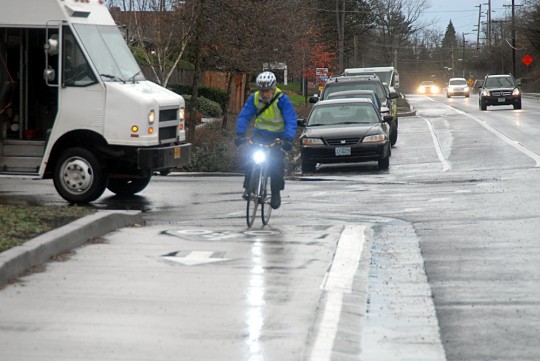
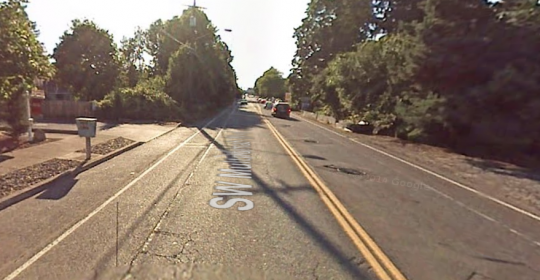
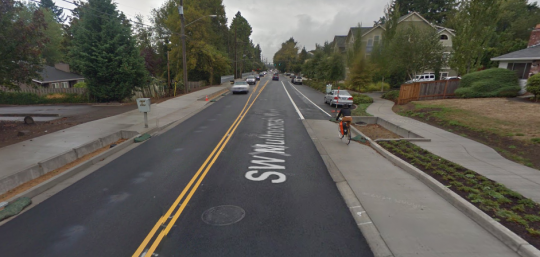
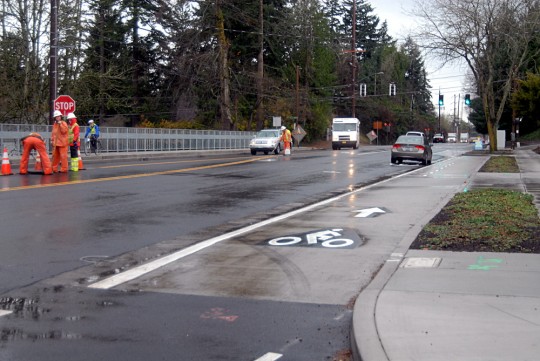
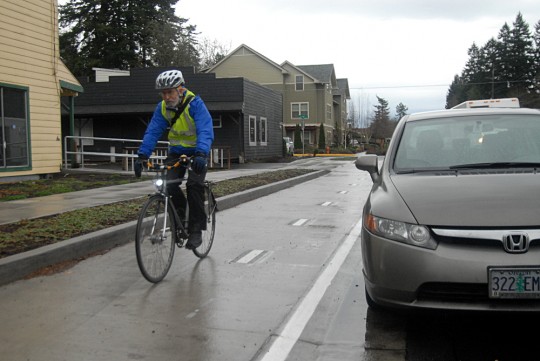
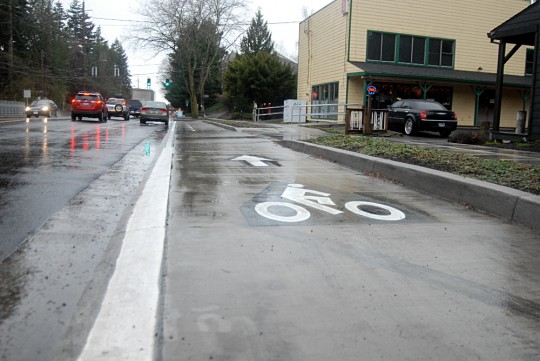
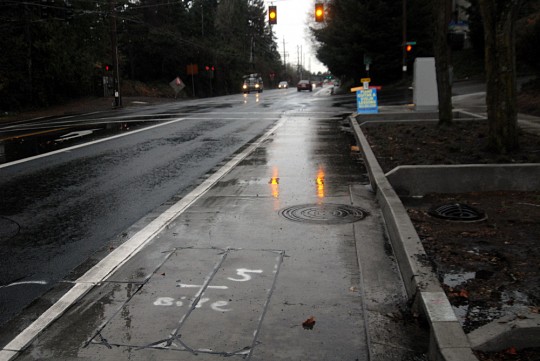
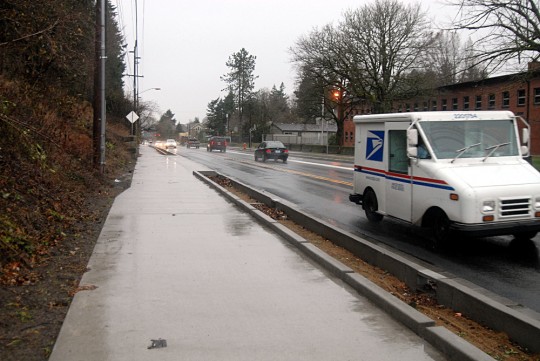
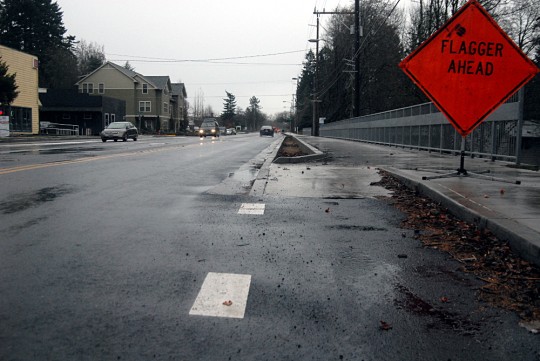
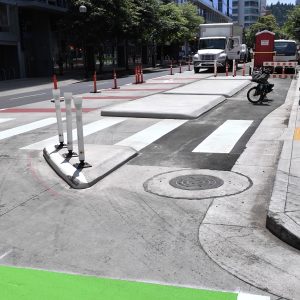
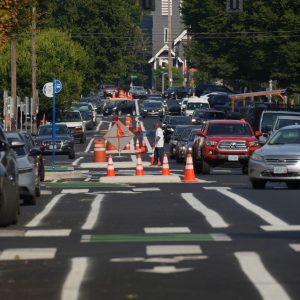
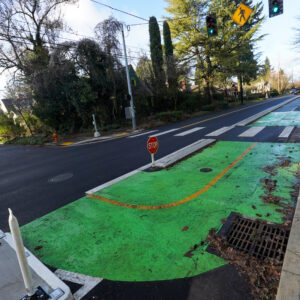
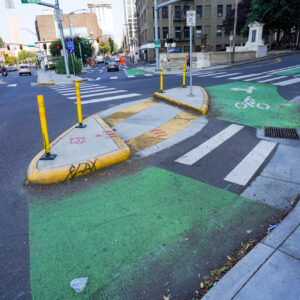
Thanks for reading.
BikePortland has served this community with independent community journalism since 2005. We rely on subscriptions from readers like you to survive. Your financial support is vital in keeping this valuable resource alive and well.
Please subscribe today to strengthen and expand our work.
those also exist in some parts of Hillsboro. My brain does not recognize them as a place where bicycles should be. I’d see that ramp and probably stay in the street.
Understandable – thankfully they have been recently marked with bicycle symbols, so it’s pretty easy to see they’re intended for bikes.
Nice – the very first picture in this report shows an unsafe intersection treatment since drivers need to pull out far enough to see beyond the parked cars, only to encounter a cyclist moving to their right to hit the sidewalk ramp. So called protected bike lanes may make you safer in between intersections — where there was almost no risk to start with — and less safe at intersections.
“Protected bike lanes” making riding less safe to show how much we care about safety…
It is unlikely that riders will approach from the right since the bike lanes are unidirectional and feed from and empty out into painted bike lanes.
Probably meant “from left to right”.
The first picture in this post is a terrible situation where a bicyclist will suddenly appear from behind cars parked all the way to the corner (there should at least have been removal of a few parking spaces there, but you know—scraps) as drivers are starting to nose out beyond the cars (parked all the way to the corner) to see cross (auto) traffic. Then not only will the cyclist suddenly appear, but will start moving closer to the nosing driver (who is trying to see around cars parked all the way to the corner), which the driver may not expect, since most operators have been taught NOT to move laterally (and not to expect lateral movement by other operators) while passing through an intersection. Surprise! The driver will either have to stop short, while wondering what in the world that crazy cyclist is doing, or the cyclist will need to swerve around, or…
All so we can preserve—or was it added(?)—parking all the way to the corner.
Lynne, I rode over a similar type of thing in Hillsboro just today–a slightly raised “Bike-Walk Lane”–near all that construction at Orenco MAX. But whereas the ones above look smooth, the one I rode on is part sidewalk, complete with ridges. When I rode over it as directed by signs, it was a horrible bumpbumpbumpbumpbump type experience, akin to being upon a trotting horse. (Fortunately it was a short stretch). Have you encountered these elsewhere in Hillsboro?
I admit I wondered if whoever designed it had ever ridden a bike before. I wish they would ride a bike on a sample of their idea first, THEN build it (or redesign & build). Or at least run their ideas by an actual cyclist first. I can only assume many suburban road designers do not generally do this.
On the other hand, what a great idea for the car lanes of streets, to “calm” car traffic: Ridges! Why not?
I’m excited about this. Multnomah Village and SW Portland has a lot of potential to be a nice corridor for density and community. Ground floor retail and residential above in mid rises. I really hope the SW corridor ends up being MAX. That is pivotal to tying all quadrants of Portland together. SW Portland can really thrive and shine like Division and Williams with their flurry of positive development and increase in housing stock. I look forward to a great evolution in SW with MAX and density.
The soil in SW doesnt lend itself to draining well. However, the future Red Electric Trail is greatly needed.
In order to activate this new addition to Multnomah Blvd, cycle tracks are needed on Multnomah Blvd from SW 40th to where it meets SW Garden Home Road. Then SW Garden Home Road needs ped and bike improvements along with the missing link of SW Capitol Highway by SW Taylors Ferry Road. It is nice to see this new addition to the Multnomah neighborhood, though.
I wouldn’t call that a protected bike lane… as you say, it’s protected by empty parking spaces… air is not a good buffer between a cyclist and a driver… Cully has the same issue…
also, if that’s a shared pathway does that mean bicycles are required to use it? I wouldn’t think so… and that creates a problem of bikes darting into the traffic lane when the bike lane ends into a sidewalk… they had room to continue the bike lane here separate from the sidewalk but they chose conflict instead of separation…
it’s better than Cully because there are no houses so there won’t be a problem with garbage cans blocking the paths…
I’m riding this every day, now. Regarding the shared ped/bike section, it’s a lot better than it looks in the photos. It’s quite wide and there are few crossings/intersections, and it starts/ends with clean transistions. I’m a big “take the lane” advocate, but it’s actually a very nice section, so no need here. On the other side, the park-on-the-left area next to Jimmy’s bar is the worst section of the entire design, but it’s only a few spaces long. Unfortunately, this is still a very new design language for the west side, so drivers still seem rather confused by the whole thing.
Also, it’s not much, but the cycletrack is raised up over the asphalt by a good few inches and it’s a different material (concrete), which does send a nice tactile a visual message to parkers. It’s not great, but it’s something.
significant factions of danish cycletracks are either flush with street level or turn into bike lanes (e.g. at or near intersections/driveways). also, some danish cycle tracks are less than an inch bove pavement due to repaving of the motorvehicle travel lanes (cycletracks last a long time, motorvehicle lanes not so much). despite this lack of “protection” danish cycletracks work fabulously well.
My observations before they put the marking on, was that motorists assumed that the cycle track was for parking (particularly near 30th where the “protected” thing is now.) One person told me that if it wasn’t for parking, then it should have no parking signs. (Apparently sidewalks are also for parking?)
spiffy,
we’re not sure what to call these things! Michael and I discussed it and there are a lot of options. I want to use a term that is both accurate and understandable. We had “raised bike lane.” Neither of us think this should be a “cycle track.” should we simply call it a “bikeway”… or how about a “separated bikeway?”
It’s a multi-use path though, right? Whatever term is used should acknowledge that.
In my earlier comment, I referred to it as a bikeway, though I suppose the elevated area to the side of the road, really is just an improved bike lane.
Its elevation doesn’t constitute much in the way of physical separation from the main lanes of the road. People could easily swerve their motor vehicle on to the elevated bike lane from the main lanes of the road, or pull their motor vehicles on to it to make deliveries and whatnot, as is done sometimes with standard, non-elevated bike lanes.
The 9′ wide MUP shown in the picture with the mail truck, is almost a cycle track, given that it has that curbed planting area separating the MUP from the main lanes.
“Sidepath”.
Not a bike lane, because it’s not always on the road; not a sidewalk, because it is designated as a place bikes should (I would argue must, under Oregon law) ride; not a cycle track, because pedestrians use it in places; not a MUP, since pedestrians don’t use it for its entire length.
I think the inability to name this kind of facility indicates some of the issues we have in dealing with the “bicycle problem”. This is a series of completely different facilities stuck end-to-end, and is not even the same on both sides of the street (if I am reading the description correctly). Also based on the description above, it sounds like the lanes designated for motorized use are the same in both directions and they pretty much go straight through at the same (unless speed “pillows” were installed) level, and they connect to other streets. Just sayin’.
Added space between vulnerable users and motor vehicles provides added time to reduce speed, or stop, before a collision. While it may not be the ideal, it is a step in the right direction of a Safe Systems approach to road design. It would be nice to add some rumble strips in the parking lane for when the space is empty.
it’s better than cully because there is no wall of parked cars obscuring sight lines and exacerbating right hook risk at every intersection. it’s also better than cully because it does have meandering S-curves every block which also, imo, limit visibility of cyclists at intersections (even though this was not the intent).
That first image makes me wince. I can easily imagine a driver creeping out to see past the parked cars on the left, just as the bike lane zigs right toward them.
It reminds me of all the zig zaggin on Cully which I find very discomforting. So much so that I prefer to take the street.
My reaction exactly–intersection needs a clear stop line and some green paint…
It needs parking removal. The zig-zag on Cully brings cyclist into view of turning motorists.
My main issue with the zig zag on Cully is I have to keep slowing down and changing my direction, which even if it’s a mild turn, forces me to reorient with traffic. It makes me feel like I’m on a temporary reroute. I REALLY dislike the Cully cycle track or whatever it’s called.
I’m not a fan either. I would have preferred the track stayed behind the planters at the corners.
Like most other “good” bike infrastructure on the West side, this project is wonderful for all of a 1/2 mile. Before and after it’s still just 1990’s bike lanes, so for the “interested but concerned crowd” it doesn’t really connect much. It’s a great start, but it won’t really be used much until the entire Multnomah corridor gets finished in 2257/Stardate 4438.27. It does seem there is some momentum brewing, though, as there are other improvements (though small in scale) like the area under the Capitol Hwy bridge that area being built as we speak.
The bikeway being elevated slightly from the adjoining main lane is a commendable effort, though I don’t feel certain that’s going to be enough of a barrier to motor vehicles, to draw to biking people that don’t want to ride directly alongside motor vehicles. And this may be a lot of people potentially interested in riding.
Side note: I’m interested in how well the elevation works to resist road debris from being spread into the bikeway, as it does in non-elevated bike lanes.
Rapid Flash Beacons: My observation of the one such signal I’ve seen in action numerous times, at the Westside Trail on Baseline Rd in Beaverton, is that they work very well. On the road, the flashing yellow lights are very visible from 200′ back or so. They begin flashing within two or three seconds after the person intending to cross, pushes the button. People driving seem to consistently stop. These lights can be excellent aids to safe use of the road.
I’m starting to think that the counterpart to “vehicular cycling” is “pedestrian cycling”. Isn’t there anything in between? Why must we feel like we need to pedal uncomfortably fast (to avoid angering motorists) or wobble along uncomfortably slowly (to negotiate zig-zags, be prepared to yield at driveways, and avoid scaring pedestrians)?
Most designs like this seem to be aimed not at “protecting” cyclists from marauding drivers, but at “protecting” drivers from having to pay attention, which they don’t really do, since they more strongly (than, say, a bike lane) suggest that cyclists *must* stay to the far right at all times, even being
hiddenprotected behind parked cars at times.Also, with all the focus on separation, why are we leaving out pedestrians? Don’t they deserve to be “protected” from scorchers who are out there mowing down everything in their path? Oh, that’s right—when it comes to mixing cars and bikes, we expect cyclists to get out of the way and give up their right-of-way rather than expecting drivers to slow down, but when it comes to mixing bikes and pedestrians, we expect cyclists to slow down and take responsibility for pedestrian safety. I forgot.
Your remarks are mostly off topic, or at best a sidetrack.
I don’t think that right to road, unconditionally allows people to hold up faster traffic. People biking on the main lanes of the road, have a right to ride their, but do have an obligation to make way for faster traffic if reasonable opportunities to do so, exist.
Your animosity expressed towards people that drive, by frequently saying they don’t pay attention, doesn’t change the fact that most drivers likely are driving responsibly, including by paying attention to the myriad of things a person driving a vehicle safely, needs to watch for. Displaying animosity towards others doesn’t help towards improving conditions.
Relative to the primary user of each, rules for sidewalks and MUP’s, differ from rules applied to the road. On the road, vehicles are the primary user, and it’s true that the slower of those using them for travel, generally need to make way for faster vehicles. People on foot, at crosswalks, excepted.
On the sidewalk, and I’d say on MUP’s as well, use of that infrastructure is conditioned by regard that need be held for the person on foot. On sidewalks and MUP’s, people riding, should be reducing their speed traveled, approximately to that of people on foot, as they encounter people walking there.
At any rate, it seems to me that as an improvement to the standard bike lane at the same level as the roadway, the elevated bike lane is a step forward to better infrastructure for biking. People don’t have to ride it if they feel doing so will present a hazard to their riding, greater than that of riding the main lanes of the road.
wsbob. Nuance. Shading. I suppose I shouldn’t be so naive as to think that everyone will understand the nature of subtle comments, or parse my statements carefully enough to recognize the specificity of meaning I’m trying to convey.
How is commenting on the design of this Multnomah Blvd. “bikeway” and the implications of said design “off topic”?
You are essentially restating what I said, only my intention was to express my dislike of always putting only cyclists on the hook for paying attention: we are blamed for being hit by cars because we should have been paying more attention or staying out of the way; we are blamed for hitting pedestrians because we should have slowed down and anticipated the unpredictable movements of those pedestrians. You seem to be perfectly accepting of mixing bicyclists with pedestrians (as part of this design does) and of the double standard of expectations applied to vehicle operators in mixed traffic (i.e., cars/bikes, bikes/peds). I am asking why we don’t apply consistent principles across the board?
I have no animosity toward drivers in general—I am one, for crying out loud. My animosity is toward those drivers who can’t be bothered to pay enough attention to avoid running me over or forcing me to take evasive action. Unfortunately, the number of incompetent drivers out there is approaching a majority, if not there already. I don’t think there is a situation that can be helped or hurt by me expressing a distaste for bad driving.
Further, fear of drivers not paying attention is the entire reason infrastructure designs like this are seemingly desired. If enough people thought that drivers would pay attention, and we applied consistent expectations to operators in mixed traffic, we wouldn’t even need separated, “protected” infrastructure like this. Even further, if we applied consistent design principles to travel ways, be they roads, cycle tracks, paths, or sidewalks, we could create “bikeways” that were actually safe and usable. What we end up with is a system in which cars have absolute priority and nothing should ever slow them down (except other cars), pedestrians are sanctified (unless they are jaywalking), and cyclists are interlopers who are either slowing down cars or running down pedestrians at every turn.
This story is about improvements made to bike lanes and to infrastructure for walking on Multnomah Blvd, rather than a free for all release of animosity towards people that drive. You say in one sentence that you don’t have that feeling towards people that drive, and then in the very next two or three sentences, you go ahead and contradict yourself. Doing that just feeds the ‘us against them’ conflict, which really, helps no one.
Reasons for less than safe functioning of roads today, has far more to do with other things besides a percentage of people driving that aren’t, as you seem to be so fond of saying, “…paying attention…”. Roads and the people using them, are under increasing pressure to handle travel the travel needs of growing populations. As roads get busier, both the people, and the roads, handle that pressure less well. There are realistic limitations to what average skilled people are able, on a consistent basis, to concentrate on. Roads are limited in terms of the size and complexity they can be designed with to handle increases in traffic.
Both reach a limit, and that’s where infrastructure such as bike lanes, improved bike lanes, cycle tracks and MUP’s come in to the picture. Doesn’t matter how careful people that drive are, many people consider the danger from motor vehicles directly next to them to be so great that riding a bike in that situation can not be a personal option.
As I wrote earlier and tried to expand on some, rules for use of sidewalks, and rules for use of the road differ. Sidewalks, even though some states, cities and towns have laws allowing people to ride bikes on them, aren’t bike lanes. People on bikes don’t have the right to use the sidewalk at speeds appropriate for bike lanes and main lanes of the road, when the sidewalk is in use by people walking. It seems some people don’t understand or accept this basic reality. If this was something widely understood, perhaps collisions such as the one down in Sacramento that critically injured a person simply standing on the sidewalk, by a person riding a bike on the sidewalk at a speed that was described as ‘a good clip’, would be less inclined to happen.
Come on, now. You’re focusing in on something that was a minor component of my original comment, and you’re not reading carefully. I am criticizing the design of this facility and the cultural attitudes that lead to such designs; you are responding with personal attacks. My original comments were on the design of this facility; particularly how it includes portions that are a MUP, hides cyclists behind parked cars, and essentially treats bicyclists as glorified pedestrians. I stated that I don’t like such designs, and that the expectations of vehicle operators in mixed traffic—as implied by designs like this one—are subject to a double standard. Those are perfectly legitimate and, IMO, on-topic comments. I further stated that the reason such facilities exist is, in large part, to protect cyclists from…inattentive drivers. If it is not for that reason, then it is strictly to keep cyclists out of the way of drivers so that those drivers can drive faster without a need to pay as much attention. I then made the (perhaps too-subtle) point that we don’t go to any such trouble to keep pedestrians out of the way of cyclists via the same level of separation or expectation. You took that as a rant against all drivers and a sweeping claim that all drivers are inattentive. Then you say I am contradicting myself. I think I can say that I don’t harbor animosity toward all drivers—just those that endanger me through their poor driving—without contradiction. Would I be contradicting myself if I said I don’t have animosity toward all people, just those that punch me in the face?
You then go on to essentially agree with me that drivers have a hard time paying attention, because who could really be expected to when the road is such a complicated, high-pressure environment; you’re just giving drivers an excuse for what we both see is a problem for many of them. You further agree with me that sidewalks are places where pedestrians have priority and cyclists must exercise extreme caution. You are agreeing with me on just about every point. The only difference is that while you accept this situation and apparently see no problems with it, I question why the expectations and roadway designs are tilted against cyclists. If you don’t agree that designs like this put cyclists at a disadvantage relative to drivers and pedestrians, and you think there is no double standard with respect to expectations of drivers and bicyclists in mixed traffic, then explain why, don’t just accuse me of misanthropy based on fragments of sentences that were ancillary to the main point of my comment to begin with.
the zig-zags and parked cars are not “world class” and nor are they best practice in denmark. in fact, the danes emphasize making bike facilities as straight as possible — for obvious reasons.
It gives the impression that we are trying to fit bikes into leftover space; we’re creating a crazy quilt of sorts, stitched together with scraps of road that nobody was using to park or walk or run trains. But if anybody really does want to park, walk, or run a train there, bike riders must weave and dodge to accommodate, not drivers or pedestrians. Yes, occasionally we throw in a patch of new “fabric”, but it is still just a patch among many others of different kinds. Examples: here on Multnomah; Moody, where bikes must cross to the opposite side of the street when tracks interfere, yet drivers continue straight on their way; Williams, where great contortions were made to move bikes from the right to the left side of the street (ostensibly because nobody was using that side for driving buses), and then we separate, then mix, then separate, then mix, then separate, then… bike and auto traffic. Granted, through drivers have lost a lane, but the lane they have Just. Goes. Straight. If a driver wants to turn left, it is expected that to make a turn, roadway position or lane use will change—but this variation in lane use and position is foisted on bicycle riders who Just. Want. To. Go. Straight. On Moody especially, lots of “new fabric” patches were used, yet the result is a non-intuitive, obstacle-strewn, ambiguous “bike path”, that creates the expectation that bicyclists, as wheeled pedestrians, will make all the diversions, do all the slowing down, and pay all the attention to avoid the built-in conflicts and navigate the twists and turns. This treatment on Multnomah appears to be one more example of the application of this philosophy: bike riders will tolerate anything—anything, no matter how inconvenient—as long as we tell them it’s safer and it cost a lot of money.
I’m very excited for this. It’s a great improvement that will provide several opportunities for improved connections as the SW Corridor is developed.
One point of concern is where the you highlighted the westbound cycle track being directed to the right of parked cars just prior to 31st. Immediately after that point, it makes a quick transition back toward the auto lanes in the same location that cars are beginning a right turn. So, bikes are moving left as they emerge from behind the parking strip and cars are merging right to make a turn at 31st. Then, a couple blocks later at 34th, the exact opposite takes place – the bike lane continues straight and the parking strip is inset to the right of the bike lane. I can’t think of a reason why the design is inconsistent.
At the east end of the eastbound bike lane (and outside the scope of this project), we really need improved crossing of Barbur to connect this route beyond Multnomah. Right now, that means waiting at the stop sign on 22nd and Barbur, next to the Boom Boom Room, to cross four general purpose lanes and a turn lane. It would be fantastic if we could continue east on Multnomah, under the Barbur overpass, and then connect to a separated bike path that climbs back up to the northbound side of Barbur – bypassing the dangerous crossing altogether.
Swing and a miss.
how so?
For me personally, it isn’t really an improvement. I never ride this section westbound, only eastbound. There was already a bike lane, and the new shared pathway isn’t any improvement. It’s wider and separated, but I fully expect to have occasional conflicts with pedestrians yelling at me for using the “sidewalk.”
That said, aside from MY needs as an eastbound cyclist it is still a major improvement overall. It will make this dark section of Multnomah much safer for pedestrians, and for westbound cyclists the new bike lane is great. Hopefully the tavern patrons are finally figuring out to put their cars in the parking spaces beyond the bike lane instead of in the bike lane, which they were doing during much of the construction period.
The biggest problems, as already mentioned, aren’t with this stretch, but with connectivity further afield. Right now a significant stretch of eastbound bike lane is closed for clean streets construction just to the west of Multnomah Village, creating a (temporary) dangerous situation.
And the most natural connection back home from eastbound Multnomah, if I’m going to take it instead of Beaverton-Hillsdale, is Barbur. I didn’t expect the recent Vermont/Newbury bridge rehab project to magically make it a nice place to ride, but there’s a huge defect for cyclists.
Fortunately the railings are higher and the ramp up to the first bridge going northbound is nice and smooth, but the second bridge has a deeply recessed drainage grate right in the middle of the path at the bottom of the ramp up onto the bridge. This is particularly dangerous here because the bridge’s sidepath is extremely narrow, and a slight deviation from course (such as recovering from a big bump like this) can cause a crash. Cyclists WILL end up being injured here, I predict. I am extremely disappointed that this drainage grate wasn’t relocated out of the way as part of this project.
how about the disabled people in wheelchairs and crutches?
“…It’s wider and separated, but I fully expect to have occasional conflicts with pedestrians yelling at me for using the “sidewalk.” …” GlowBoy
You’re good, as long as when riding the MUP section when people on foot are present, you’re riding as though it’s the sidewalk their presence near you makes it. Objections to people on bikes, whizzing by people on foot, within the close confines of narrow MUP’s and sidewalks, are valid complaints.
This was my main commute for several years. Multnomah was not particularly stressful for riding once I got used to the speed differential (there’s freeway on/off ramps on the other side of Barbur) but it was dreadful for walking. Despite living less than 2 blocks from Jimmy’s I almost never went there because it was unpleasant to get at on foot. The bike improvements are…fine, I guess…but I’m really glad to see some proper accommodation for foot traffic.
Why wasn’t this design considered for N Williams?
Money, I assume. Even without the drainage improvement, $6 million a mile is more than Portland is used to spending on anything except streetcar tracks.
$6M seems a bit excessive for what amounts to extra concrete and paint. Also, the idea that money is more important than safety is frightening.
Not only extra concrete– needed infrastructure improvements you’ll not be able to see by looking. Money well-spent. But more needs to go from the pie toward bikes and safety in general, I agree.
I’ve got no idea how these expenses add up, but Austin’s new bike plan (created by the bike-friendliest engineer+planner in a quite bike-friendly transpo department) assumes the medium budget for a full street reconstruction similar to this one would cost $17,600,000 per mile per side of street. $8 million, the low end of Austin’s range, is fairly close to the total cost per lane-mile on this project ($6.7 million).
They also had to accommodate for storm water management. It also appears the car lanes were repaved.
I use the lanes built by this project on a daily basis. I’ve been riding this route for over 20 years, and there’s no doubt that there have been huge improvements over that time. Yes, it is easy to quibble about specific design elements and the relatively small area of improved cycleway, but this project provides significant improvements for both cycling and storm-water management. I’m glad I live in a city that is trying to put to use some of the latest innovations in promoting alternatives to driving and in keeping storm-water out of the overtaxed sewer system. In most other places in the U.S. cyclists would be lucky to get a wider road and a little paint, if that. Kudos to the city for this one (and I have my fingers crossed that someday I can ride Barbur with anything near the better sense of security I now feel on Multnomah…).
There are some unfortunate transitions along this corridor where the path leaves the roadway for the raised path…sharper turns than i would want to use at commute speed, tho probably fine for the < 12mph crowd. I expect to see the confident riders just avoiding the raised lane for the sake of continuity and speed. [east bound at 37th in particular]
Nice piece, Michael.
“Another advantage of this setup is that the right door of a car opens much less than the left one.”
It’s a little late in the game, but you should add “often”, lest someone misunderstand the sense of this.
I’m on this section of road in various forms of transit pretty much daily. Until I read the article, I had no idea that the south side of the road was a shared path. I simply stayed in the main traffic lane.
That said, one suggestion for future projects might be to get more signage as to the intent of lanes, and get them up ASAP. If you don’t know where to ride, or where a rider is going, the element of predictability is lost. That’s when things get scary.
I’ve figured out the secret: roads named “Multnomah” get protected bike facilities before others. Multnomah Lane, Multnomah Avenue, Multnomah Circle, Multnomah Way are next.
The Multnomah Blvd corridor leads to Multnomah Village, and leads to the heart of Garden Home and the start of the Fanno Creek Trail, bus 45, and eventually bus 56 off of SW 92nd Ave and SW Scholls Ferry Road. The industrial area is near SW Scholls Ferry and SW Allen Blvd.
Washington County has spent over $24,000,000 on SW Oleson Road, which cross SW Garden Home Road, since 2004.
how are you supposed to cross back over to North bound transit to enter freeway on ramp on route to terwilliger?? i would not want to be stuck on the wrong side of the street just to ride this path for 1.5 minutes!!!! i hate the new design.
You mean while eastbound out of this stretch, m bodd? Good question, but as far as I know this cross was just as bad before these changes. Did they make it worse somehow?
How many bikes took the east-bound Multnomah Blvd onramp that went to I-5 North? It would be nice to have an improved bike option to get from Multnomah Blvd to the Terwilliger curves area.
There is an all-new crosswalk on Multnomah Blvd at roughly 26th Ave. Rapid-flash beacon.
I don’t recall ever seeing bikes on the I-5 on ramp section. To go north on Terwilliger, I take Capitol Hwy through Hillsdale. To go south, cross Barbur at 22nd and then take the first right at 19th – then cut through South Burlingame to avoid Taylor’s Ferry.
In any case, I don’t understand m bodd’s comments. This project didn’t change access to Terwilliger and there are still opportunities to cross Multnomah at the intersections. I guess if you are turning left out of the old armory, you’d be blocked from the MUP, but that’s the only spot I can think of.
To be clear, there is a specified bike lane on the onramp to I-5 north that can be taken back to Barbur via Terwilliger. It’s a little scary crossing over I-5 with not much of a railing on the bridge and debris in the bike lane, but I have taken it a few times.
Grade separated bike lane?
… is what to call it.